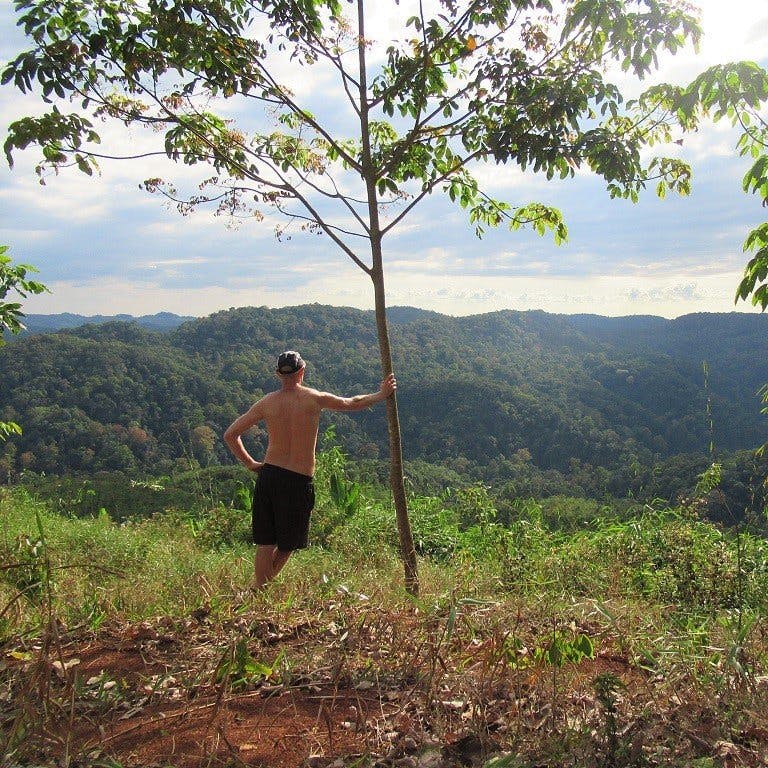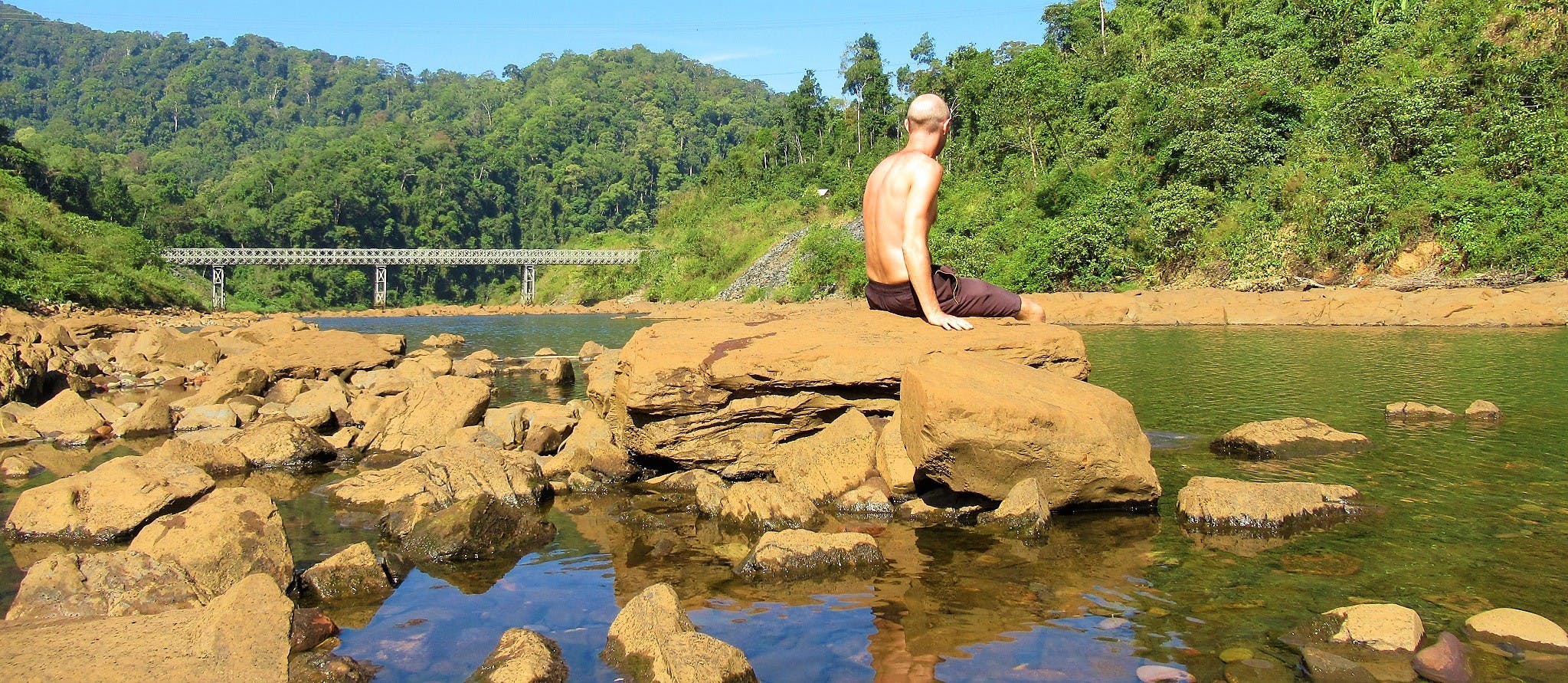First published February 2018 | Words and photos by Vietnam Coracle
This post was last updated 6 years ago. Please check the comments section for possible updates, or read more on my Updates & Accuracy page.
INTRODUCTION | GUIDE | MAP | RELATED POSTS
Lunar New Year is a time of gathering: of family and friends; of people and parties. But the Lunar New Year holiday (Tết) in Vietnam is also a time of noise and crowds; of pollution and overcharging. As much as I enjoy the former (not to mention the fabulous food), I’ve grown weary of the latter. This Lunar New Year (February 2018), I undertook to spend my Tết holiday in relative peace and solitude. I took my motorbike, my tent, and my guitar and set off for a week. Fortunately, I have friends in some of the corners of south-central Vietnam that I travelled through, and was lucky enough to visit them along the way, so my Tết was not entirely ‘people-less’. What follows isn’t a guide or a travelogue: it’s simply an illustrated scrapbook of some of the places I saw and stayed: a snapshot of an alternative Lunar New Year holiday spent on the road and under the sky.

During the Tet Lunar New Year holiday, 2018, I tried to get away from the crowds on a camping road trip
[Back Top]
SCRAPBOOK: LUNAR NEW YEAR, 2018
I spent my time riding around the south-central triangle: the coast and the mountains between Saigon, Nha Trang, Dalat and Gia Nghia. This is a region of Vietnam I know well: I’ve probably explored this area more than any other part of the country since I arrived in 2005. I started along the coast roads, wanting to enjoy the seaside, in the glorious dry season weather, before the rush of domestic tourists after New Year’s Day (February 16, 2018). Then I headed inland, to the mountains, to get away from the holiday crowds, and to ride some quieter roads and find good wild camping in the cool highland climate. The road trip was just under 2,000km and lasted 11 days. The map below isn’t a route map: it shows places I camped and passed through while on the road. (For more specific details and guides to these areas, see Related Posts.)
MAP:
Some of the places I camped & passed through during Tết 2018
View in a LARGER MAP
[Back Top]
Arriving on a sunny afternoon in Nha Trang, with the city filled with yellow flowers for Tết, I sat down for a bowl of bún ốc – snail noodle soup with bamboo shoots. This was my last stop on the coast before I turned westwards, into the mountains.

A bowl of bún ốc (snail noodle soup) in Nha Trang, my last stop along the coast before heading inland
Road DT656 follows the Cai River valley as it passes through Phước Bình National Park, a striking mix of arid, boulder-strewn mountains, jungle-clad hills, and cool, clear waterways with sandy beaches that are ideal camping territory.

Camping on a sandy beach on the Cai River in Phuoc Binh National Park, Ninh Thuan Province
The days are hot and dry, but the nights are cool in Ninh Thuan Province during this time of year: perfect camping conditions. Sleeping in the open is so much easier during the dry season, and camping next to fresh water is always a treat, especially when it’s deep enough to swim.


Camping is easy in southern Vietnam’s dry season (November-April), especially next to a clear river
Passing through Dalat, I stopped to buy some rượu sim (rose myrtle-infused rice liquor) from a family-run farm-restaurant in the pine forests near Suối Vàng Lake. Sweet and flowery in flavour but mild in strength, rượu sim is one of my favourite tipples in the Central Highlands. Around Dalat, the pine forests were dry and the coffee blossom was in bloom, as well as other sweet-smelling flowers that you don’t find in the hotter lowland regions of Vietnam, like the fragrant sweet pea flower in the picture below (at least I think it’s sweet pea).

Sweet pea: because Dalat’s climate is so cool, flowers grow here you don’t find in the hot, lowland regions
Moving further west on good, empty roads, I realize how easily accessible the highlands are now, since the completion of big new infrastructure. Many of the roads are built to facilitate dam construction and the clearing of forest for agricultural use. The dams form huge reservoirs which in turn become local natural attractions.


New roads have opened access to the Central Highlands: this is Dak Nong Province, Chua Thuy Lake
Before the mass cultivation of coffee and other cash crops, these highlands were dense forests stretching all the way to the Cambodian border. Today, there’s still large expanses of jungle left, but it’s disappearing fast as farming encroaches.

Looking out over a forested mountainside from a bare ridge where jungle has been cleared for agriculture
Camping on a ridge in the forests somewhere between Gia Nghia and Cat Tien, I scared myself before bed by reading about how tigers roamed the wartime bases of the Viet Minh in the Việt Bắc region (northeast Vietnam), during the Franco-Viet Minh War (1946-1954). Guard dogs were eaten by tigers at night, and, in the 1950s, travellers on the road to Dalat were warned not to get out of their vehicles for risk being mauled by prowling tigers. Today, it’s estimated there are only some 40 Indochinese tigers left in the wild in Vietnam. Tonight, that figure comforts me, but I still woke up terrified at the sound of each footfall approaching my tent.

Camping on a ridge in the forests & mountains of Dak Nong Province, once home to Indochinese tigers
Early morning on the ridge is magical. A mist fills the bowl created by the encircling mountains, hanging above the forest so that only the tallest trees break the grey veil of vapour. Birdsong fills the morning air – the trees are alive with them, flitting from branch to branch so that the entire canopy shimmers and shakes.


In the early mornings on the ridge, a mist fills the valley, hovering above the jungle canopy
The Dong Nai River is one of the longest in Vietnam. It’s dammed at multiple points in the highlands. I was able to bathe in it on the mornings I camped. Despite the air being cool, the water was quite warm. Once this river reaches the lowlands, near Saigon, it’s wide, muddy and polluted; but here in the mountains it’s clear.

The Dong Nai River, one of the longest in Vietnam, snakes through the highlands & is good for bathing
Behind Cat Tien National Park, a small clear river runs through a tight valley populated by ethnic minority communities, who grow coffee and cashew trees – whose pungent fruit is the dominant smell in the valley – along the banks and fish in the river. This was my last night in the open, before heading back to the busier, more industrialized lowlands.


My last night in the open, near Cat Tien: camping was an effective way to avoid the holiday crowds
[Back Top]
RELATED POSTS:
[Back Top]


Hello Tom,
really enjoyed this post! Do you think is possible to do camping on the path from Nha Trang to the north too?
I will do Saigon Hanoi by motorbike soon and I would like to mix camping nights with homestay/hotel nights just to save some bucks.
cheers
Hi Elana,
It depends what route you plan to take. Obviously, if you’re going to be following the main highways then camping’s not really possible, but if you use smaller, quieter roads through less populated areas (which most of the routes on my site try to use) then you can find places to camp every now and then. For example, the Western Ho Chi Minh Road is very sparsely populated and good for camping (see section 5 of this guide). There are also some official campsites on the coast north of Nha Trang, where you’re allowed to pitch your own tent. Hom Gom Sandbar is a nice place to camp, for example.
I hope this helps,
Tom
Hi tom
Your site is most beautiful
I,ve been reading for hours with great interest….for my next byke ride to vietnam
My appartment is in poipet….near siem reap,cambodia and i m trying to figure a way to
Cross directly towards nah trang….first trip to north to hanoi
And the second part to saigon…..and back to phnom phen…and finally siem riep again…
Everything is there…..i m so thrilled i found you
ThANKS………this is worthed gold………david
Hi Conrad,
Great to hear you’re planning a road trip through Vietnam. I’m sure you’ll love it.
There’s a border crossing near Kon Tum which I think you can take: it’s where Cambodia, Laos and Vietnam meet.
Tom
I really enjoyed this post Tom (and your blog overall – great job!). I’m newly arrived to Vietnam just one month ago from the US, by way of Bali and Australia. Over the past year, since I left “back home” I have found myself yearning for solitude more and more, such as you experienced for yourself this TET. And so I find myself already preparing to move from Nha Trang onward to Quy Nhon, next month. I have visions of a little house on the edge of town, backing up to the jungle. Greenery all around, the sounds of birds chirping, and maybe distant giggles from children. Perhaps it’s my age getting the better of me, but the noise and the haste leave me longing for something far more simple. Anyway, thanks for sharing your journey through so many years in Vietnam; it has already proven to be a fascinating and hilariously strange journey for me. Cheers, Allyson
Hi Allyson,
Thanks, I’m glad you enjoyed this post. Yes, I like the frenetic energy of Vietnam’s cities but I wouldn’t be able to deal with it long if I weren’t able to get out into the peace and quiet of the countryside whenever I wanted 🙂
I hope you find your piece (peace) of paradise in Quy Nhon,
Tom